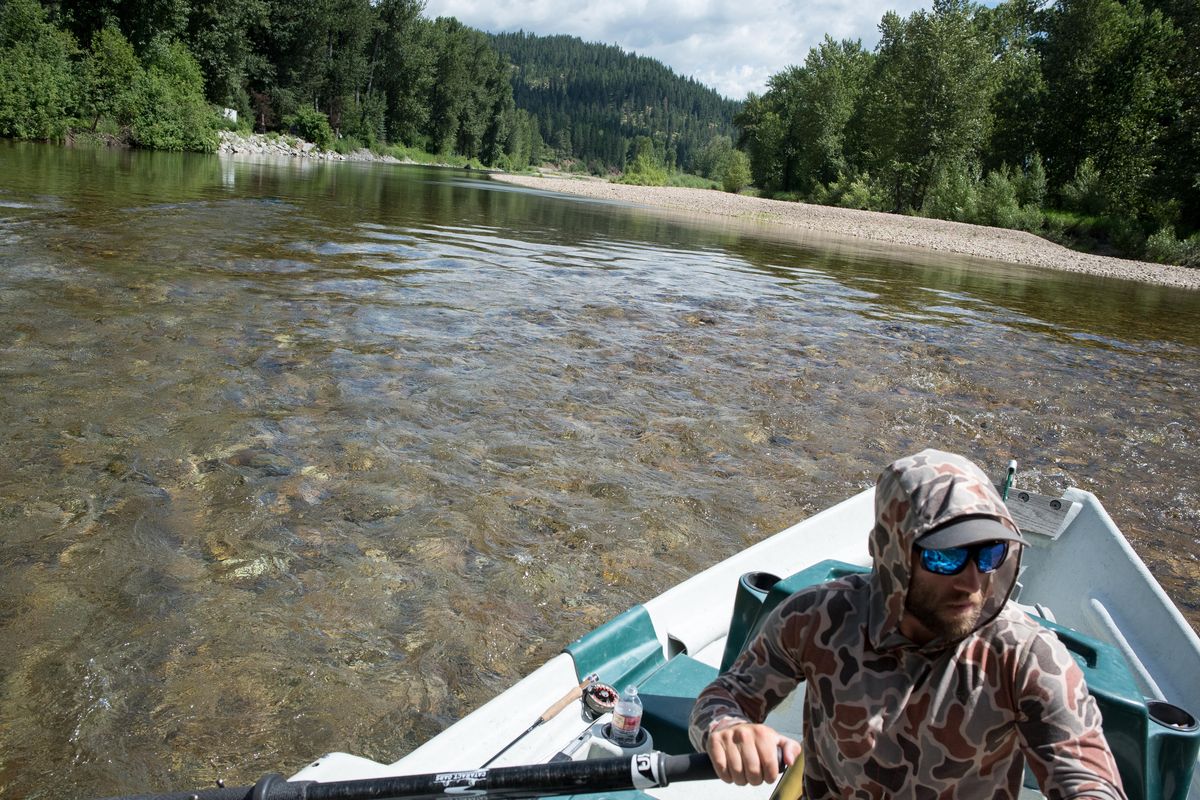With cooler spring, fishing stays hot on Coeur d’Alene North Fork

On a windy Wednesday last week, Greg Gatti helped me catch my first cutthroat trout on the North Fork of the Coeur d’Alene River.
While I held the rod and brought the 14-inch fish in, I have a sinking suspicion that he did most of the work. His expert eyes and skill behind the oars of his boat set me up for success, despite my many novice mistakes.
Still, the thrill and accomplishment of hooking the fish was undeniable. Gatti, despite having guided on the Coeur d’Alene and St. Joe rivers for about four years, was appreciative and complimentary of my haul.
“Most of the rivers I fished in, if we caught a 14-inch fish we talked about it for years,” he said.
That statement is partly a reflection of the fact that Gatti grew up in western Maine hooking brook trout.
But it’s also highlights the overall success of North Idaho’s cutthroat fishery.
Since 2008, when catch-and-release fishing rules went into effect in the Coeur d’Alene and St. Joe rivers, both fisheries have become a premier fly fishing destination for waders and boaters alike.
“When it comes to cutthroat trout, I’d put the St. Joe and the Coeur d’Alene up against any other river in the Lower 48,” Gatti said.
Of course, as a guide, he has an economic incentive to overstate the virtues of the fishery, but data collected by the Idaho Department of Fish and Game backs up Gatti’s assessment.
“The North Fork continues to be an outstanding cutthroat fishery,” said Andy Dux, the regional fisheries manager for IDFG.
Since catch-and-release rules went into effect in 2008, the overall density of fish has increased slightly. In a 2018 snorkeling survey, IDFG staff observed, on average, one cutthroat fish per every 100 cubic meters, which represents a slight increase over 2008. More important, the quality of fish has increased with the mean density of cutthroat larger than 12 inches has roughly doubled since 2008.
“The biggest difference is the quality of fish have improved,” Dux said.
The recovery of the cutthroat fishery has been a longtime coming. Thirty-five years ago, rapacious logging and mining practices had decimated more than 30 percent of the spawning habitat for the native cutthroat.
But a series of regulations and angler activism slowly brought the fishery back.

Now, Dux said, the issue facing cutthroat anglers on the North Fork is one of access, not opportunity.
“We’ve put a fair bit of effort into trying to provide improved float access to the river over the last decade,” he said.
This summer, IDFG hopes to complete work on a newly acquire piece of riverfront property just upstream of Albert’s Landing. Known as Freeman’s Eddy, it was owned by the Idaho Department of Transportation for years. IDFG bought it about six months ago and it should be open to the public in 2020, Dux said.
As for the anglers themselves, the North Fork and the St. Joe are perhaps the worst-kept secret left.
“The North Idaho cutthroat waters are absolute gems,” said Josh Mills, an avid angler and board member of the Wild Steelhead Coalition. “Those fish are God’s gifts to fly fishermen and women. Typically, cutties are more willing than their cousins on the rainbow side to rise to a dry fly, making it a grand place to spend the summer.”
That willingness to go for dry flies has long made them a popular and relatively easy fish to go for, Gatti said. But as angling pressure increases on the Coeur d’Alene and St. Joe, the fish have become savvier.
“These fish are getting a lot more educated,” Gatti said. “They are getting tougher to fish.
We’re having to fish longer leader, lighter line, and be a lot more selective with bug selection than we have in the past.”
In addition to the increased fishing pressure, Gatti has seen a rise in ill-prepared floaters and boaters. Just a week before our trip, he saved several teenagers who were caught in a downed tree, known as a strainer.
But on Wednesday, there were no party floaters and few other anglers. Gatti and I used a combination of nymph (a fly imitating a water-loving bug) and a dry fly (a fly imitating a bug on the surface of the water). I got numerous bites and would have caught more fish if I had any semblance of skill.
“It’s been one of the more fishable springs ever,” Gatti said.
Fishing should stay good on the North Fork through the summer, although by the end of the month all guided float trips be finished for the season.
Meanwhile, the St. Joe tends to fish better late into the summer because it gets more snowmelt, said Sean Visintainer, the owner of the Silver Bow Fly Shop.
A cooler spring has kept the North Fork fishing well, but Visintainer recommends anglers start also looking at the St. Joe.
“(But) it’s a good time of year to fish either one, really,” he said.
For a good trip on the St. Joe, Visintainer recommends wade fishing upstream of Avery Idaho, although he notes the fishing between Avery and Calder Idaho is also good.
“The amount of access that we have and public land on these rivers is incredible,” Visintainer said.
